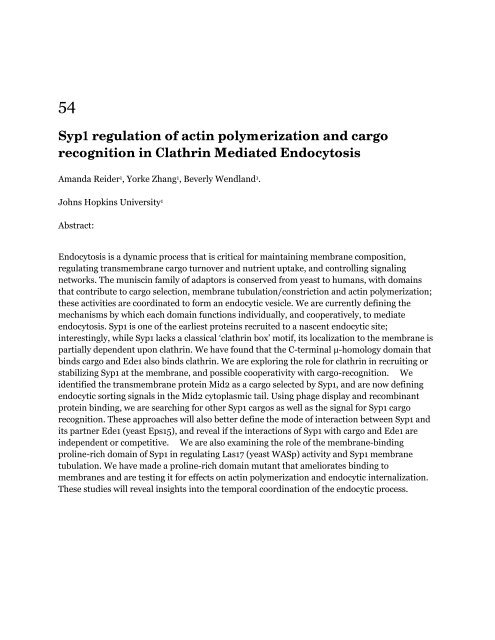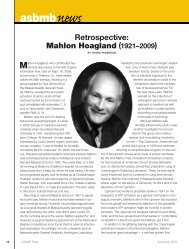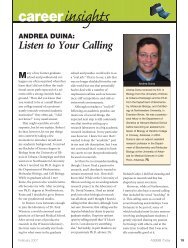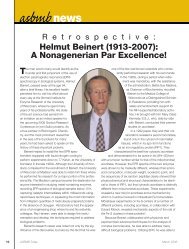View Program - asbmb
View Program - asbmb
View Program - asbmb
- TAGS
- program
- asbmb
- www.asbmb.org
You also want an ePaper? Increase the reach of your titles
YUMPU automatically turns print PDFs into web optimized ePapers that Google loves.
54<br />
Syp1 regulation of actin polymerization and cargo<br />
recognition in Clathrin Mediated Endocytosis<br />
Amanda Reider 1 , Yorke Zhang 1 , Beverly Wendland 1 .<br />
Johns Hopkins University 1<br />
Abstract:<br />
Endocytosis is a dynamic process that is critical for maintaining membrane composition,<br />
regulating transmembrane cargo turnover and nutrient uptake, and controlling signaling<br />
networks. The muniscin family of adaptors is conserved from yeast to humans, with domains<br />
that contribute to cargo selection, membrane tubulation/constriction and actin polymerization;<br />
these activities are coordinated to form an endocytic vesicle. We are currently defining the<br />
mechanisms by which each domain functions individually, and cooperatively, to mediate<br />
endocytosis. Syp1 is one of the earliest proteins recruited to a nascent endocytic site;<br />
interestingly, while Syp1 lacks a classical ‘clathrin box’ motif, its localization to the membrane is<br />
partially dependent upon clathrin. We have found that the C-terminal μ-homology domain that<br />
binds cargo and Ede1 also binds clathrin. We are exploring the role for clathrin in recruiting or<br />
stabilizing Syp1 at the membrane, and possible cooperativity with cargo-recognition. We<br />
identified the transmembrane protein Mid2 as a cargo selected by Syp1, and are now defining<br />
endocytic sorting signals in the Mid2 cytoplasmic tail. Using phage display and recombinant<br />
protein binding, we are searching for other Syp1 cargos as well as the signal for Syp1 cargo<br />
recognition. These approaches will also better define the mode of interaction between Syp1 and<br />
its partner Ede1 (yeast Eps15), and reveal if the interactions of Syp1 with cargo and Ede1 are<br />
independent or competitive. We are also examining the role of the membrane-binding<br />
proline-rich domain of Syp1 in regulating Las17 (yeast WASp) activity and Syp1 membrane<br />
tubulation. We have made a proline-rich domain mutant that ameliorates binding to<br />
membranes and are testing it for effects on actin polymerization and endocytic internalization.<br />
These studies will reveal insights into the temporal coordination of the endocytic process.






